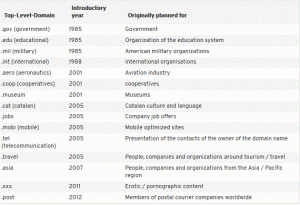An Internet address is made up of several parts: one of them is the top-level domain name (TLD), also called extension or termination. There are different types of TLDs: termination. pk is, for example, specific to Pakistan. A gTLD (for generic top-level domain) is, on the contrary, a transnational extension: the most widespread so far is obviously. com, for commercial. The latter, like all TLDs, is part of a domain name system, which represents, so to speak, the list of addresses on the Web. What are the differences between these gTLDs and other top-level domain names? And how are they distributed?
Country-specific and generic extensions
Among the top-level domain names, there are gTLDs from ccTLDs. Examples of famous generic TLDs outside. com is .org, .net and .info. The ccTLDs (from the Country-code top-level domain) are on the contrary specific to the corresponding countries: for example, .uk for the United Kingdom. A generic top-level domain name does not induce a geographic area, but rather a thematic field: termination .org, for the organization, generally refers to non-profit organizations. The generic extension. info, on the other hand, suggests that the website is informative. GTLDs, unlike ccTLDs, are always at least three letters long.
In the early days of the Internet, there were only a handful of generic top-level domain names. In January 1985, the extensions .com, .org, .net, .edu, .gov, .int and .mil or. arpa was introduced as the first generic extensions. CcTLDs followed in the same year. Hundreds of generic terminations have been developed in the meantime, notably due to the gradual introduction of new gTLDs.
Stand out with a unique domain name and a personalized email address!
Sponsored and non-sponsored gTLDs
There are two basic forms of generic TLDs: those that are sponsored and those that are not. To receive an Internet address with a sponsored TLD, certain conditions must be met. These editions are defined by sponsors (companies or organizations), who are also responsible for the directives and the general operation of their TLD. Gov.pk is, for example, an extension sponsored by the Pakistani government, just like it is .int for international organizations or .jobs for job vacancies from companies.
On the contrary, non-sponsored TLDs are operated and controlled centrally. It is indeed the ICANN (Internet Corporation for Assigned Names and Numbers) which is responsible for this, in collaboration with various partners. It was initially anticipated, when the first unsponsored TLD was introduced, that its acquisition required certain conditions to be met. A website should, as with sponsored gTLDs, have a clear connection to the sponsored extension: the extension. com, for example, should only be used by companies, .net should relate to internet service providers while .pro should induce a professional relationship in various fields of application. These plans were however abandoned and the unsponsored gTLDs were made available to all interested individuals, companies, organizations, etc.
Overview of traditional gTLDs
Due to the mass allocations of these new TLDs, it is difficult to speak of an orderly distribution of these generic extensions. In our article on new TLDs, you will find more complete information on the first “new” extensions granted. The following two tables, on the contrary, provide an overview of classic generic top-level domain names, separating those sponsored from those not sponsored.
A termination is however not shown because it presents a particular case: arpa. It was the first extension integrated into the domain name system in 1985 when the Internet was called Arpanet. The. arpa extension is currently used for the Internet infrastructure, which is why the TLD is not publicly available for registration.
Non-sponsored generic top-level domain names
Sponsored generic extensions
gTLDs: extensions full of history and future
Generic extensions are the cornerstone of the Web, from a technical point of view, and have existed since the beginning of the Internet. Their attribution will also play a big role in the future. These gTLDs could indeed prove to be very relevant.
The choice of addresses available with the most popular endings such as .com, .org or .net clearly weakens over time. This also applies to country-specific TLDs, as shown in the following graph. So new alternatives become essential. Thanks to the new gTLDs, a multitude of new possibilities for web addresses are available, which pleases website operators.
Thanks to the new gTLDs, you have many options for reserving the desired domain name, which was previously not available with terminations .com or .pk for example.
About the author
DMTwebhosting.com‘s Editorial Team prides itself on bringing you the latest web hosting news and the best web hosting articles!
You could also link to the news and articles sections:


